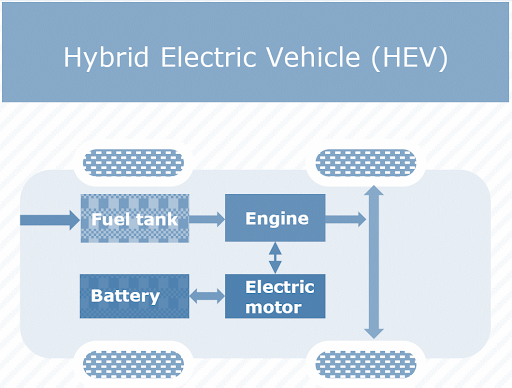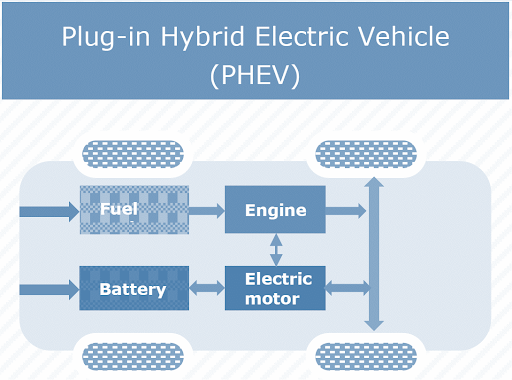Indian Economy
Push for Hybrid Electric Vehicles
- 13 Jul 2024
- 12 min read
For Prelims: Battery Electric Vehicles (BEVs), Hybrid Vehicles. Faster Adoption and Manufacturing of Electric Vehicles (FAME) Scheme II, National Electric Mobility Mission Plan (NEMMP), National Mission on Transformative Mobility and Battery Storage, Go Electric campaign, Production Linked Incentive (PLI) scheme.
For Mains: Hybrid Vehicles as alternative to Electric Vehicles, Electric Vehicles Manufacturing and Adoption - challenges and opportunities, EVs and Global Goals of Net Zero Emission.
Why in News?
Recently, the state government of Uttar Pradesh announced the waiver of registration fees for strong hybrid and plug-in hybrid electric vehicles (EVs).
- This move aligns Uttar Pradesh with Tamil Nadu and Chandigarh, which also offer incentives to promote cleaner alternatives to petrol and diesel vehicles.
What is a Hybrid Electric Vehicle (HEV)?
- About Electric Vehicle:
- An Electric Vehicle (EV) is defined as a vehicle that can be powered by an electric motor that draws electricity from a battery and is capable of being charged from an external source.
- Types of Elective Vehicles (EVs):
- Battery Electric Vehicle (BEV): These are fully powered by electricity. These are more efficient compared to hybrid and plug-in hybrids.
- Fuel Cell Electric Vehicle (FCEV): Electric energy for EVs is produced from chemical energy. For Example, a Hydrogen FCEV.
- Hybrid Electric Vehicle (HEV): It is also called Strong Hybrid EV. The vehicle uses both the internal combustion (usually petrol) engine and the battery-powered motor powertrain.
-
The petrol engine is used both to drive and charge when the battery is empty. These vehicles are not as efficient as fully electric or plug-in hybrid vehicles.
-
- Plug-in Hybrid Electric Vehicle (PHEV): These use both an internal combustion engine and a battery charged from an external socket (they have a plug).
- Vehicle’s battery can be charged with an external electricity source only and not by engine.
- PHEVs are more efficient than HEVs but less efficient than BEVs.
- PHEVs can run in at least 2 modes:
- Hybrid Mode, in which both electricity and petrol/diesel are employed.
- All-electric Mode, in which the motor and battery provide all the car’s energy.
- Significance of Hybrid EVs:
-
Practicality in the Medium Term (5-10 years): Since they do not require an external charging infrastructure, hybrids are seen as a practical and viable option for the medium term as India gradually moves towards full electrification of its vehicle fleet. This transition is expected to take 5-10 years.
-
Cost of Ownership Perspective: Hybrids are considered cost-effective as several state governments are giving waivers on registration fees, RTO fees etc.
- For Example, UP government has announced a 100% waiver on registration fees for strong hybrids, potentially saving buyers up to Rs 3.5 lakh.
- Hybrid cars have better fuel economy compared to conventional fuel cars leading to cost savings for drivers over time.
- Critical for Decarbonisation Drive: Hybrid vehicles play a role in India's decarbonisation efforts. Hybrid vehicles have lower total (well-to-wheel, or WTW) carbon emissions than both electric and traditional ICE vehicles for similarly sized vehicles.
- Hybrids emit 133 g/km of CO2, while EVs emit 158 g/km. This translates to hybrids being 16% less polluting than the corresponding EV.
- These are 176 g/km for petrol and 201 g/km for diesel vehicles.
-
Note
- In February 2023, the Tamil Nadu government announced incentives in the form of road tax, registration, and permit fee exemptions for strong hybrids.
- The Chandigarh administration also offers road tax rebate on strong hybrid vehicles priced below Rs 20 lakh.
What are Government of India’s Initiatives to Promote EV Adoption?
- Faster Adoption and Manufacturing of Electric Vehicles (FAME) Scheme II
-
National Mission on Transformative Mobility and Battery Storage
-
Production Linked Incentive (PLI) scheme: Incentives for the manufacturing of EVs and components
- Ministry of Power's Revised Guidelines on Charging Infrastructure: At least one charging station to be present in a grid of 3 km and at every 25 km on both sides of the highways.
- Amendment to Model Building Bye-laws, 2016 (MBBL): Mandatory to set aside 20% of the parking space for EV charging facilities in residential and commercial buildings.
- India’s support to the global EV30@30 campaign
What are the Challenges in Adoption of Electric Vehicles in India?
- Higher Cost: High upfront cost is a primary barrier for electric vehicles compared to conventional internal combustion engine (ICE) vehicles. The cost of batteries, which is a significant portion of an EV's price, remains high, making EVs less affordable for many consumers, especially in a price-sensitive market like India.
-
Lack of Clean Energy: Much of India's electricity is generated from burning coal, thus relying on coal to generate power for all the EVs would defeat the purpose of reducing carbon emissions through EV adoption.
-
Supply Chain Issues: Global supply chain issues for lithium-ion batteries are significant, with over 90% of lithium production concentrated in countries like Chile, Argentina, Bolivia, Australia, and China.
- India's demand for these batteries is expected to grow over 30% annually until 2030, requiring over 50,000 tonnes of lithium for EV battery production. This reliance makes India heavily dependent on imports from a few countries.
- Underdeveloped Charging Infrastructure: India's current charging infrastructure is not sufficient for the increased demand for EVs, with only 12,146 public EV charging stations mostly in urban areas, it lags far behind China, which has 1.8 million electric charging stations.
- An analysis by the World Bank (WB) has found that investing in charging infrastructure is between four and seven times more effective in ensuring EV adoption compared with providing upfront purchase subsidies.
- Suboptimal Battery Technology: Current EV batteries have limited capacity and voltage, which hinders driving range. This, along with limited charging stations, aerodynamic drag, and vehicle weight, makes it difficult for drivers to travel long distances without recharging.
-
Persistent Resistance to Change: Indian consumers persistently resist adopting EVs due to lack of awareness and general reluctance to embrace new technologies, especially in rural areas, despite the long-term economic and environmental benefits.
Upsurge in Hybrid Vehicle Sales:
- Sales data reveals a significant increase in HEV adoption in India. Strong hybrids grew from 0.5% to 2.2% of the total market share between FY23 and FY24.
- This trend aligns with global observations. Hybrid sales are surging internationally, particularly in the US and Europe, where they are outpacing BEV growth.
Way Forward
- Addressing Cost Concerns:
- Government needs to focus on providing demand incentives and targeted subsidies, especially for middle-income and budget segments, developing a network of battery swapping stations to reduce charging time and alleviate range anxiety and more focus on promoting the adoption of electric two-wheelers to create a larger EV user base.
- Enhancing Charging Infrastructure:
-
There is a need to prioritise the installation of fast-charging stations along major highways and urban centres, and to integrate renewable energy sources like solar and wind power to ensure EVs contribute to reduced emissions.
-
-
Boosting Battery Technology and Supply Chain:
-
There is a need to incentivize the establishment of domestic lithium-ion cell manufacturing facilities to reduce import dependence and implement efficient battery recycling programs to address environmental concerns and reduce reliance on virgin raw materials.
-
-
Promoting Consumer Awareness and Education:
-
Targeted public awareness campaigns should be conducted to address misconceptions and highlight the benefits of EVs. There should be focus on rural outreach programs to promote the adoption of electric two-wheelers and three-wheelers for agricultural and transportation needs.
-
UPSC Civil Services Examination, Previous Year Questions (PYQs)
Prelims
Q. In the cities of our country, which among the following atmospheric gases are normally considered in calculating the value of Air Quality Index? (2016)
- Carbon dioxide
- Carbon monoxide
- Nitrogen dioxide
- Sulphur dioxide
- Methane
Select the correct answer using the code given below:
(a) 1, 2 and 3 only
(b) 2, 3 and 4 only
(c) 1, 4 and 5 only
(d) 1, 2, 3, 4 and 5
Ans: (b)
Exp:
Q. With reference to the Agreement at the UNFCCC Meeting in Paris in 2015, which of the following statements is/are correct? (2016)
- The Agreement was signed by all the member countries of the UN and it will go into effect in 2017.
- The Agreement aims to limit the greenhouse gas emissions so that the rise in average global temperature by the end of this century does not exceed 2ºC or even 1.5ºC above pre-industrial levels.
- Developed countries acknowledged their historical responsibility in global warming and committed to donate $ 1000 billion a year from 2020 to help developing countries to cope with climate change.
Select the correct answer using the code given below:
(a) 1 and 3 only
(b) 2 only
(c) 2 and 3 only
(d) 1, 2 and 3
Ans: (b)
Mains
Q. How is efficient and affordable urban mass transport key to the rapid economic development in India? (2019)









